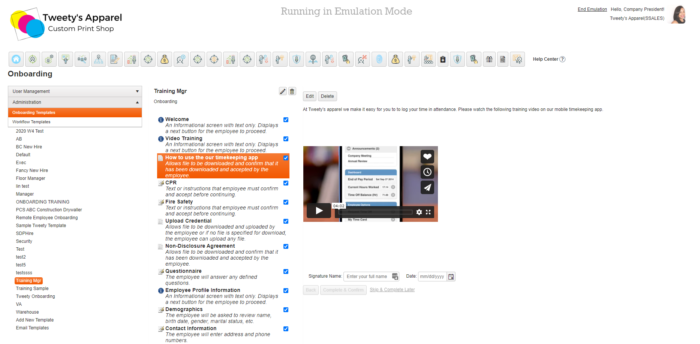
The perfect candidate just returned your offer letter. Fantastic! Especially after the past year we’ve had, every win deserves to be celebrated. But before you start popping champagne to celebrate finally rebuilding your workforce, let’s take just a few minutes to strategize the future of onboarding at your organization.
If you’re like most businesses, chances are your onboarding process wasn’t as well-designed as it could have been–even pre-pandemic! As a matter of fact, according to leading HR provider Mammoth HR, a whopping 60% of companies indicated they don’t set any goals or milestones for new hires.
Like most business owners, you have a lot of things on your plate. Onboarding isn’t always top of mind. Often, it consists of a short orientation meeting followed by reams of forms for the new hire to complete over the next few hours. Then, the new employee is sent to their manager for training (maybe).
But that may not actually be the best way to onboard employees. (On second thought, we’re pretty sure it isn’t!) So here are three steps to take advantage of the fresh start COVID-19 has given us, bring your onboarding up to speed for 2021, and ace every first impression with new hires moving forward.
1. Start By Setting 1-3 SMART Goals
Remember that statistic we shared earlier about 60% of companies not setting goals or milestones for new hires? Let’s not be part of that statistic! Before you can improve your current onboarding process, it’s important to focus on what you’re trying to achieve. Using the SMART goal-setting framework, pick out 1-3 goals for your dream onboarding program. Things like:
- Retention: Increasing your percentage of new hires who stay at your organization for 3+ years from 20% to 50%.
- Productivity: Cutting down on the amount of time it takes new hires to perform at the average level of their peers by 1 month.
- Turnover: Decreasing turnover related to burnout from understaffing by 75%.
- Satisfaction: Tracking employee satisfaction or eNPS and improving your score by 10 points.
Top Tip: When employees go through structured onboarding, they are 58% more likely to remain with the organization after three years.
2. Brainstorm Your Dream Onboarding Program
Now that you’ve laid out some solid goals for your new onboarding program, it’s time to start building. Start by making a list of everything you would include in your dream scenario. For example:
- Reach out the day before with parking instructions, a reminder of anything they need to bring, and the dress code
- Workplace tour and introductions
- Orientation presentation and introduce your company’s history, culture, and values
- Meet-and-greet with the CEO or VP to inspire and show your new hire they’re not just a “cog in the wheel”
- Review business policies and procedures
- Time and attendance instructions and overview
- Provide payroll instructions
- Department lunch or happy hour for the new hire to get to know their peers
- Complete new hire paperwork and benefits enrollment
Top Tip: This is also a great time to check in with your existing employees about their onboarding experiences. What worked and what didn’t? What was the best new hire experience they ever had? (At your organization or a previous workplace.)
3. Tackle the “How”
In the planning phase above, you’ll greatly benefit from having a “the sky’s the limit” mentality. Instead of thinking, “no, that’s not possible,” think, “yes, and _____.” By remaining open to any (even outlandish!) ideas at the outset, you allow yourself to catch a glimpse of the greatness you could achieve.
Only after you’ve gotten out every wild and crazy idea you can think of is it time to consider the “how”. Allow yourself to take a different approach than you previously have to make more items on your list feasible.
For example, maybe it would be physically impossible for your HR Manager to take each new hire through every item on your wishlist in one day. (Especially with how long it can take to complete the paperwork portion!) However, instead of immediately writing off new ideas–that could genuinely greatly improve your new hire experience–ask yourself if there is a way that more of these items could become feasible.
Drawing on the example wishlist above, could you…
…Create a “day before” email draft that you can save and send to every new hire?
Instead of scrambling to gather this information after each hiring spree, simply customize the email with your new hire’s name. After that, just review the template on an annual basis to keep it up-to-date.
…Better plan your workplace tour for an optimal time?
So, not high-traffic times, when deliveries usually take place, or during the leadership team’s weekly meeting. These will all result in delays or even needing to re-do your introductory rounds–taking up your valuable onboarding time!
…Consider pre-recording your company orientation presentation?
We love this idea. You could watch the video with your new hire and maybe even bust out some popcorn for fun! That way, you’ll guarantee that each new hire gets the same information, save time on prep, and can plan exactly for how long this will take.
…Automate tasks like policy review, form completion, and benefits enrollment?
Instead of taking hours for employees to write the same information on twenty different forms and then having to decipher their writing to enter it into your payroll & HR platform, consider taking advantage of onboarding software.
This technology digitally collects employee information to populate state and federal forms and automatically adds new hires to payroll. As a result, you can improve your new hire experience, reduce transcription errors, and significantly speed up what is arguably the most time-consuming part of the onboarding process.
Plus, onboarding software like our module in SDP Connect can give you the ability to embed videos and training on other items on your list like:
- Policies and procedures
- Time and attendance instructions
- Payroll instructions
As an added benefit, this type of technology guarantees a consistent and streamlined onboarding process for each new hire.
Top Tip: Employers are required by law to pay employees for time spent onboarding and training. So any improvements to make this process more efficient (without compromising the new hire experience) are a win in our book!
Learn more about Onboarding in SDP Connect here.
4. Tailor The Experience (Bonus!)
Okay, so we know this article is supposed to show you how to build a better onboarding program in three steps. But if you want to build your best onboarding program, then you won’t ignore this fourth bonus step.
Steps 1-3 are a great place to start, but once you’ve created a solid base program, the best thing you can do for your new hires is to copy your core onboarding program and modify it (by department, role, hourly/salary, or whatever makes sense for your business) to build a more tailored experience. Here’s what that could look like:
- Having slightly modified “day before” email templates (i.e. dress code may be different for a warehouse worker than for your front desk assistant)
- Keeping your workplace tour, introductions, and standard company overview presentation the same across the board
- Including different timekeeping instructions and protocols for hourly employees vs. salaried employees
- Adding requirements to upload copies of licenses or certifications for certain roles (i.e. drivers license, medical license, HR certification)
- Including different videos or information on PTO accruals or benefits if these vary throughout your organization

Customizing onboarding templates is easy in SDP Connect with drag-and-drop editing!
Next Steps
We hope you find this framework to build a better (or best!) onboarding program helpful. Don’t let your new knowledge go to waste, though! Comment below your 1-3 SMART goals to commit to revamping your onboarding program today. And if you’d like to learn more about paperless onboarding in SDP Connect, then let us know here!
Need a little extra support with new hire compliance? No matter your situation, SDP has layers of HR support that can help. Learn more about our HR Support Services here. And don’t forget to follow us on Facebook, Twitter, and LinkedIn for even more business tips & news!
Photo by Edmond Dantès from Pexels
